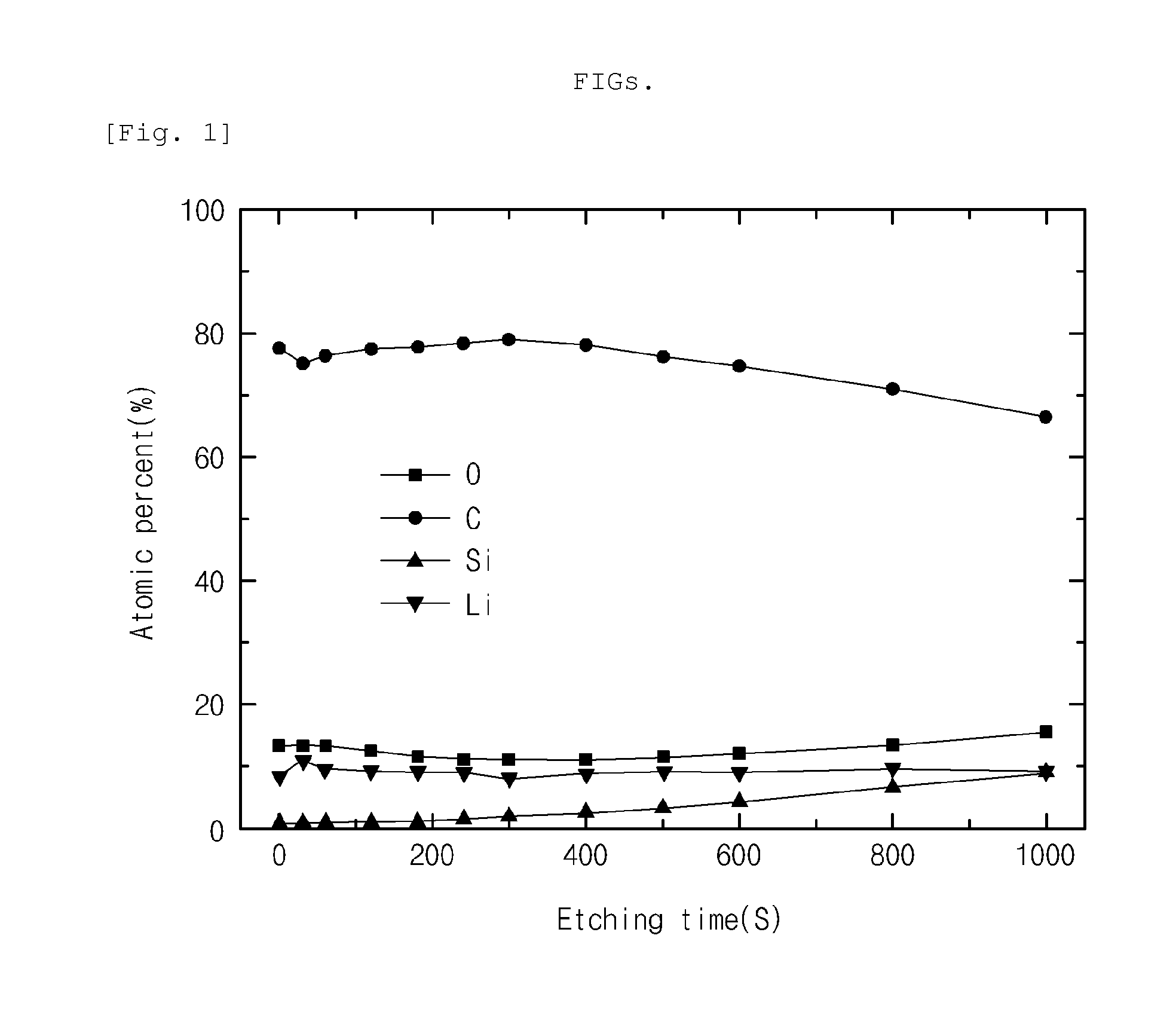Silicon-based composite and production method thereof
a technology of composite materials and composite materials, applied in the field of silicon-based composites, can solve the problems of reduced battery capacity, reduced safety, and reduced and achieve the effect of increasing the initial efficiency of secondary batteries
- Summary
- Abstract
- Description
- Claims
- Application Information
AI Technical Summary
Benefits of technology
Problems solved by technology
Method used
Image
Examples
example 1
Production of Silicon-based Composite Coating of Silicon Monoxide (SiO) with Carbon (1)
[0046]20 g of silicon monoxide as silicon oxide was put in a rotary tube furnace, argon gas was flown at a rate of 0.5 L / min., and the temperature was elevated to 1000° C. at a rate of 5° C. / min. While the rotary tube furnace was rotated at a rate of 10 rpm / min, argon gas and acetylene gas were flown at rates of 1.8 L / min and 0.3 L / min, respectively, and a heat treatment was performed at 800° C. for 3 hours to produce silicon monoxide coated with carbon. At that time, the amount of carbon was 5 parts by weight based on the silicon monoxide.
[0047]Mixing of Silicon Monoxide Coated with Carbon and Lithium Oxide (2)
[0048]The amount of Li2O was adjusted such that the amount of lithium was 7 parts by weight based on the silicon monoxide coated with carbon, and the silicon monoxide and Li2O powder were uniformly mixed using a mortar. Since Li2° powder exhibits white color, when the silicon monoxide and L...
example 2
Production of Secondary Battery
[0051]The silicon-based composite produced in Example 1 as an anode active material, an acetylene black as a conductive material, polyvinylidenefluoride as a binder were mixed at a weight ratio of 85:5:10, and then the mixture thus obtained was mixed with N-methyl-2-pyrrolidone that is a solvent, to produce a slurry. The produced slurry was coated on a surface of a copper collector to a thickness of 65 μm, dried and rolled, and then punched to produce an anode.
[0052]10 wt % of fluoro ethylene carbonate (FEC) was added to an anhydrous electrolyte solvent which was produced by mixing ethylene carbonate and diethylcarbonate at a volume rate of 30:70 to produce 1M LiPF6 anhydrous electrolyte.
[0053]A lithium metal foil was used as a counter electrode, a polyolefin separator was disposed between both electrodes, and then the electrolyte was injected to produce a coin type secondary battery.
experimental example 1
Initial Efficiency Analysis
[0056]To investigate initial efficiencies of the respective secondary batteries produced in Example 2 and Comparative
[0057]Examples 3 and 4, a first cycle charge capacity and a first cycle discharge capacity were measured, and the ratio (initial efficiency) of the first cycle discharge capacity to the first cycle charge capacity is shown in Table 1.
TABLE 1Raw materialInitial efficiencyExample 2SiO / C + Li2O86.03Comparative Example 3SiO + Li2O64.46Comparative Example 4SiO / C74.50
[0058]As shown in Table 1, it can be known that the secondary battery (Example 2) including the silicon-based composite according to an embodiment of the present invention has the initial efficiency of about 86%, which is higher by about 20% than that in Comparative Example 3 in which carbon was not coated. Also, compared to Comparative Example 4 in which lithium was not mixed, it can be known that the initial efficiency of Example 2 is higher by about 12%. Thus, it can be known that ...
PUM
| Property | Measurement | Unit |
|---|---|---|
| temperature | aaaaa | aaaaa |
| thickness | aaaaa | aaaaa |
| temperature | aaaaa | aaaaa |
Abstract
Description
Claims
Application Information
 Login to view more
Login to view more - R&D Engineer
- R&D Manager
- IP Professional
- Industry Leading Data Capabilities
- Powerful AI technology
- Patent DNA Extraction
Browse by: Latest US Patents, China's latest patents, Technical Efficacy Thesaurus, Application Domain, Technology Topic.
© 2024 PatSnap. All rights reserved.Legal|Privacy policy|Modern Slavery Act Transparency Statement|Sitemap


